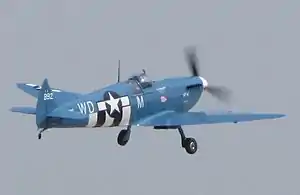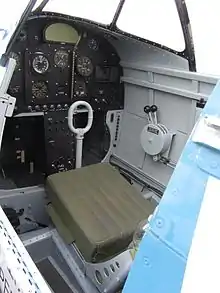Supermarine Aircraft Spitfire
The Supermarine Aircraft Spitfire is an Australian homebuilt aircraft produced in kit form by Supermarine Aircraft.[1][2][3] A replica of the famous British Supermarine Spitfire World War II fighter, it was originally produced to 75% scale. Subsequent models have increased the scale of the fuselage and added a second seat.
| Supermarine Aircraft Spitfire | |
|---|---|
 | |
| Role | Homebuilt aircraft |
| National origin | Australia |
| Manufacturer | Supermarine Aircraft |
| Designer | Michael O'Sullivan |
| First flight | November 1994 |
| Number built | 100 (Dec 2011)[1] |
Design and development
Australian pilot and aviation engineer Mike O'Sullivan had always wanted a Spitfire and built a replica for his own use in 1991. This was followed by a 75 hp (56 kW), Rotax-powered prototype in 1994. The next year, in 1995, he joined with business partner John McCarron to form the Supermarine Aircraft company and produce all-Australian homebuild aircraft kits. In the event, the constant-speed, four-blade propeller would be obtained from a specialist firm in New Zealand.[4] Supermarine Aircraft is not related to the original British Supermarine company, although the owners of the Supermarine marque have given their permission for the name to be used.[5]
The first production model was named the Spitfire Mk25 and was a 75% scale replica of the original Supermarine Spitfire design. The stressed skin structure consists of 2024 aluminium alloy skins, formers and longerons with some fibre-glass mouldings for parts such as fairings and air scoops. The design features electrically-operated retractable undercarriage, with differential braking to the main wheels, and landing flaps.
The later Spitfire MK26 uses the MK25 wings with the fuselage increased to 80% scale to provide room for a passenger seat in tandem behind the pilot. The Mk26B has a 90% scale fuselage. The Spitfire kit has the same power-to-weight ratio as the original.[6]
The aircraft was reviewed by the Australian Ultralight Federation in 2001. It was approved as meeting Australian rules for kit-built aircraft.[7] Supermarine began promoting the kit plane to the US market in 2004.[8] The aircraft has been approved by the British Light Aircraft Association.[9][10]
The company has since moved to Cisco Airport, Texas in the US, which O'Sullivan also manages.[5]
Powerplant
The prototype MK25 was initially fitted with a Rotax engine, before development progressed through a series of more powerful Jabiru types.[4] Early production models were powered by eight-cylinder, 200 hp (149 kW) Jabiru engines made in Australia. Subsequently, the company introduced a V6 Isuzu engine conversion, producing 260 or 320 hp (194 or 239 kW) with supercharger, as well as a V8 General Motors automotive engine conversion producing 430 hp (321 kW).[4][11]
Early versions of the Spitfire MK26 used an eight-cylinder 180 hp (134 kW) Jabiru 5100 horizontally opposed aero engine, but early installations suffered from inadequate cooling. The company now offers a V6 engine. The normally aspirated version of this engine produces 226 hp (169 kW) with a supercharged version producing up to 310 hp (231 kW).[12]
The maximum rpm of a propeller (at about 2800 depending on its diameter) is about half that at the maximum torque/power rpm of about 5500 rpm for a car engine, which therefore must be fitted with a drive reduction unit. Such units absorb about 20% of the engine power and therefore the normally aspirated Isuzu unit delivers the same maximum power as the Jabiru 5100. Recent developments of the Jabiru engine range by Rotec have produced replacement water-cooled cylinder heads for the 5100. This has removed the overheating problems and also allowed the nose cowling of the Mk26 to be reshaped to remove the air intake and considerably reduce the frontal area to be in keeping with the original sleek design of the Spitfire.
Variants
.jpg.webp)
- MK25
- Single-seat version, no longer produced, 75% scale. This was a true 'three-quarter' scale size of the original World War Two Mk 5 Spitfire.
- MK26
- Two-seat version. '80% scale'. Discontinued by 2011 in favor of the '90%' version. The '80% scale' refers only to the fuselage that was lengthened to 80% of the original MK5 Spitfire. The same wing was used from the 75% scale aircraft, resulting in a wingspan and undercarriage height identical to the original 75% scale aircraft.[2]
- MK26b
- Improved MK26. Option of dual controls, '90% scale'. Again the '90% scale' refers only to the fuselage, that was again lengthened (in fact to 89.5% the length of the original MK5 Spitfire); the fuselage was also made fatter in the cockpit area. The same wing was used from the 75% scale aircraft, resulting in a wingspan and undercarriage height identical to the original 75% scale aircraft.
Construction
Construction of the Spitfire requires metalworking skills and tools and makes extensive use of aviation grade pull rivets or pop rivets. Pre-assembled kits are provided but still leave the builder with 1,200 man-hours of work to be completed.[13]
Operational history
Over 92 Spitfires have now been sold around the world.[6]
Fatal accidents/controversy
After a fatal accident at Gympie, Australia, in October 2010, involving a Mk 26, the coroner reported, on December 29, 2014. The inquest concluded that Michael O’Sullivan, the CEO of Supermarine Pty Ltd, admitted that the aircraft test flight period had only been 20 hours instead of the 37.5 hours declared, that he had "knowingly falsified documents to achieve registration of his aircraft with RA-Aus (Recreational Aviation Australia), rather than the more stringent registration with CASA (Civil Aviation Safety Authority)", and he admitted to "significantly understating the weight of the aircraft (by about 200kg)" (around half of the aircraft's stated empty weight of 401 kg).[14]
In 2013, A MK26 80% scale Spitfire crashed in Adelaide, Australia. The pilot, as the only passenger in the aircraft, died as a result of the accident. Official findings show pilot error as the main contributor of the accident, however, the ATSB report stated: "The aircraft was prone to aerodynamically stall with little or no aerodynamic precursors and it was not fitted with a stall warning device, increasing the risk of inadvertent stall."[15]
Specifications (MK26b)

Data from Supermarine Aircraft [16]
General characteristics
- Length: 23 ft 9 in (7.24 m)
- Wingspan: 27 ft 8 in (8.43 m)
- Height: 6 ft 9 in (2.06 m)
- Wing area: 122 sq ft (11.3 m2)
- Empty weight: 992 lb (450 kg)
- Gross weight: 1,785 lb (810 kg)
- Powerplant: 1 × General Motors-Isuzu V-6 liquid-cooled piston engine, 226 hp (169 kW)
- Propellers: 3-bladed Ivoprop composite propeller
Performance
- Maximum speed: 265 mph (426 km/h, 230 kn)
- Cruise speed: 184 mph (296 km/h, 160 kn)
- Stall speed: 48 mph (77 km/h, 42 kn)
- g limits: +6 -4 (limited aerobatics)
- Rate of climb: 2,500 ft/min (13 m/s)
- Wing loading: 14.6 lb/sq ft (71 kg/m2)
See also
Related development
Aircraft of comparable role, configuration, and era
References
- Vandermeullen, Richard: 2011 Kit Aircraft Buyer's Guide, Kitplanes, Volume 28, Number 12, December 2011, page 71. Belvoir Publications. ISSN 0891-1851
- Bayerl, Robby; Martin Berkemeier; et al: World Directory of Leisure Aviation 2011-12, page 121. WDLA UK, Lancaster UK, 2011. ISSN 1368-485X
- Tacke, Willi; Marino Boric; et al: World Directory of Light Aviation 2015-16, page 128. Flying Pages Europe SARL, 2015. ISSN 1368-485X
- "Supermarine Spitfire Mk 26". Retrieved 2009-08-17.
- "A new generation of Spitfires takes to the air". The Telegraph. Retrieved 11 July 2012.
- "Reports & Articles". National Historical Machinery Association (Australia). Retrieved 2009-08-17.
- "AMATEUR BUILT ULTRALIGHT AIRCRAFT - CAO 95.55 PARA 1.5, MAJOR PORTION RULE, ELIGIBLE AIRCRAFT KIT LISTING" (pdf). Australian Ultralight Federation. 2001-07-04. Retrieved 2009-08-18.
- "Spitfire Reborn as Thoroughbred Experimental". Aero-News Network. 2004-04-16. Retrieved 2009-08-18.
- Light Aircraft Association - Approved aircraft list Retrieved: 31 January 2009
- Light Aircraft Association - Approved aircraft list Retrieved: 18 August 2009
- Laurence, Charles (6 July 2012). "A new generation of Spitfires takes to the air". The Telegraph. London. ISSN 0307-1235. Retrieved 20 November 2018.
- Supermarine Aircraft - Engine and Propeller Retrieved: 31 January 2009
- Supermarine Aircraft - Construction Retrieved: 31 January 2009
- Baldwin, Maxine (29 December 2014). "Office of the Coroner - Findings of Inquest" (PDF). courts.qld.gov.au. Retrieved 19 July 2018.
- Australian Transport Safety Bureau, Loss of control involving scale-replica Spitfire, VH-VSF, 28 January 2014.
- Supermarine Aircraft - Specifications Retrieved: 31 January 2009
External links
| Wikimedia Commons has media related to Supermarine Spitfire Mk 26. |
- Supermarine Aircraft web site.
- Spitfire MK26, Pilotfriend.com
- Image of Spitfire MK26, pbase.com
- Supermarine Spitfire Mk 26b, retrothing.com
